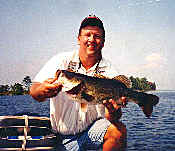Lakecaster Online Archives – February, 1999
Are you having a hard time getting that bass fishing fire burning in your insides in 1999? Has your hand become permanently molded in the shape of a TV remote? Well, let me lay some statistics on you that might give you the boost you need to give up that Lay-Z-Boy for a butt seat. Did you know that 12 of the top 45 and 4 of the top 8 largemouths ever recorded in the State of Texas were caught in the month February? Did you know that the lake records at Lake Pinkston, Echo Lake, Possum Kingdom and Houston County Lake were all caught in the month of February? February is Big Bass month in East Texas and you cannot catch one from your Lay-Z-Boy. So get your coat and don’t forget your slicker and come to Big Sam for some Big Bass.
The water level is back to normal and the water temperature is starting to rise. These two factors will definitely put those big bass on the prowl and make ’em hungry. And anytime that the bass are scattered and feeding, my hand reaches for my Rat-L-Trap rod. A lot of people think that a Rat-L-Trap is an idiot bait, that anyone can just throw it out and reel it in and catch fish. And many times, it is just that easy. But for those other times, I’m going to give you a few tips that have worked for me in the past.
First, I suppose, would be when to fish a Rat-L-Trap this time of year. Well, early and late are always good, but some of the best action is going to be on the cloudy, overcast, rainy days. These are the kind of days when the bass are really roaming and feeding. They are fairly easy to catch when you find one but the problem is that they are scattered and moving around in search of food. This where the rattles in a Rat-L-Trap come in handy. The bass can hear those rattles from a long distance and are attracted to this clicking/rattling noise. Then, when they get closer, they can feel the vibration of the bait in the water and will home in on this to make the kill.
One of the best places to make this work for you is on a large, main lake moss bed like Needmore Point or Farmers Point or Buck Bay. These type areas hold fish all year long and now is no different. Also the spawning urge is beginning to move those bass shallow, so don’t forget to look in the back of those coves for activity. Especially late in the afternoon after the sun has had a chance to warm some of that shallow water. Anytime that you can find moss with 3′-10′ of water over the top of it, you have found prime Rat-L-Trap water. Bass can be caught at these type locations without the cloud cover, but the wind has to be blowing. There is something about bright sunshine and no wind that really slows down the Rat-L-Trap bite.
What about bait color and size? There is definitely something positive about showing the bass something different, so I throw a lot of different colors and sometimes change the size of my bait. Pumpkinseed w/ green flake, firetiger, chartreuse w/ blue back, chrome w/ blue back, and chrome w/ black back are just some of the colors that I catch fish on all the time. Longear sunfish was introduced last year that has gotten to be one of my favorites. Never leave the ramp without a Red Crawfish or Bleedin’ Shiner Trap tied on at least one of your rods. I usually start out throwing one of the new one ounce ‘Traps because it just seems to produce better fish for me. If the action with this one is slower than what I would like, then I’ll step down to the 3/4 ounce or maybe the 1/2 ounce. I rarely go smaller than 1/2 ounce this time of year because I’m always looking for a big bite and it is definitely true that big baits catch big bass.
This time of year you want to be bumping or “ticking” the moss with your ‘Trap. Make your cast, allow the bait to sink to about the level of the top of the moss (usually a 3 or 4 count) and then begin a slow retrieve with your rod held low to the water. If you don’t feel your bait hitting moss occasionally, then slow down. Don’t get in a big hurry. Remember, the water temperature is just now getting into the 60’s and these fish are still fairly sluggish. Whenever you feel your bait bump something, sweep your rod sideways, just like you are setting the hook. Sometimes the bump you feel will be a bass and you will be setting the hook. Other times, your bait will be bumping moss and that sudden burst of speed that you give your bait will be just what it takes to generate a strike.
This leads to equipment requirements. For line, I prefer fresh, premium quality 17-20 pound test green monofilament. I like to use a medium heavy action 6′-6″ or 7′-0″ All Star worm or jig rod (model WR1, SJ1 or CRC) when I am crankin’ a ‘Trap through the moss. I feel that a rod of this type is very helpful to successful Rat-L-Trap fishing because these rods are stiffer and allow you to “rip” the bait free from the moss. Many of my guide clients try to use fiberglass crankbait rods and when they try to “rip” the bait they often just end up pulling in a big ball of moss. Also, I use like to use a quality, high-speed baitcasting reel with a thumb bar release.
Here’s a trick to keep you from breaking your line. Many times a ‘Trap fish will bury itself in the moss no matter how hard you try to keep their head up. The best thing to do when this happens is to get directly over the top of the fish and pull straight up on the line with your hands. I’m not sure why, but this really works. Another thing to help you keep bass on the line is to stick your rod as deep as you can in the water and reel as fast as you can, whenever see your line start coming to the top of the water. When a bass jumps with a Rat-L-Trap in his mouth, he is difficult to keep hooked. But, if you’ll do the rod dippin’, hard reelin’ trick then you can prevent some of those jumps.
I sincerely hope that at least some of the information that I have provided was enlightening or maybe entertaining but most of all helpful and educational. If you would like some first hand instruction on black bass fishing on Lake Livingston or Sam Rayburn, I guide full time on both of these lakes and can be reached at (409) 563-4063. Also, I am selling my ’98 guide boat. It is a ’98 20′ Ranger R91 with a 200 hp Mercury EFI. It is fully tournament rigged and ready. E-mail me at fairbanks@detnet.com for further details. Until next time, catch all you can and release all you catch. Good luck, be safe out there and may God bless.
Sponsored by: Ranger Boats, Motorguide, Pro-Kon-Trol, Lowrance Electronics, All Star Graphite Rods, Trojan Batteries, Turbo Props, Dual Pro Battery Chargers, Bill Lewis Lures, Gene Larew Lures, Stanley Jigs, Castaic Soft Baits, VMC Hooks and Ocean Waves Sunglasses.
Copyright © 1999 – 2005 by Lakecaster Publications, Onalaska, Tx. All rights reserved. Usage rights granted to Toledo-Bend.Com





